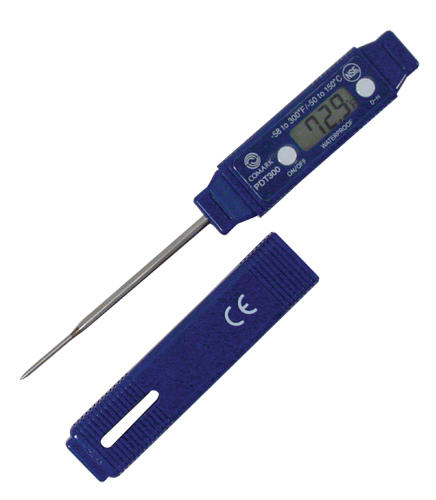 Above is an image of my favorite thermometer for everyday food service use, the COMARK PDT-300.
Above is an image of my favorite thermometer for everyday food service use, the COMARK PDT-300.
Here is why:
- It is NSF approved and meets the Colorado requirement for a thin probe thermometer to measure the temperatures of thin foods such as patties, fillets, etc.
- It reads quickly, in just a few seconds.
- It is reliable and durable, withstanding drops and continual use.
- The battery just keeps going…mine typically lasts about a year, and you can imagine how often I use my thermometer.
- Performing an ice water calibration is simple and takes less than one minute.
- The price is unbeatable…less than $20 at Tundra Specialties.
One question that frequently arises is where to place the thermometer when taking the temperature of food. That is best answered by the FDA (Food and Drug Administration) in Annex 5 of the 2009 FDA Model Food Code:
The geometric center or thickest part of a product are the points of measurement of product temperature particularly when measuring critical limits for cooking.
The geometric center of a product is usually the point of measurement of product temperature particularly when measuring the critical limit for cold holding.
As a former health department food safety manager, I’ve used many types over the years, and in my opinion, it’s the best for the money for everyday food service use. I regularly demonstrate it to my customers, and they invariably ask me where to buy one – the answer is easy; I tell them Tundra Restaurant Supply.
My name is Jim Austin and since 2001 I’ve been a food safety consultant in private practice, based in Denver, Colorado. I am a former Colorado local health department manager who was responsible for the food inspection program. I know how the world of government regulation really works, and I enjoy helping my customers deal confidently with the health department and protect their business interests.
For a free initial consultation, please contact me:
Colorado Restaurant Consulting
https://www.coloradorestaurantconsulting.com/
 Corner Booth Blog | TundraFMP Restaurant Supply, News & Equipment Blog
Corner Booth Blog | TundraFMP Restaurant Supply, News & Equipment Blog




I have this thermometer for my grill station. My cooks complain that its broken. It reads the temp at the tip, unlike other cheap instant-reads, that usually read somewhere in the center of the probe. Why doesn’t this termometer indicate where it reads the temp in a busy-line-cook-proof way? The cheap ones have a little dimple in the probe to indicate where the temperatue is being taken from.
This is an irrelevant problem if you are temping a sixth pan of gravy (over 140? OK!). but pretty important when a few undercooked or overcooked steaks get comped every night because the thermometer isn’t idiot-proof.
Hi Dan,
The answer to your question is that the spec sheet for the PDT-300 states that it reads at the tip. When I show this thermometer to my customers, I very clearly tell them that it reads at the tip. That is why this sort of thermometer is required for thin foods. But it can also be used for thick foods, like the gravy you cited. Just make sure the thin tip is in the “geometric center” of the product (using the FDA language), or more commonly referred to as the thickest part of the product.
Also, the dimple on the probe of dial stem thermometers does not indicate the point of temperature measurement. The area between the dimple to the end of the probe (~ 2 inches) is the distance along which the temperature is averaged. It is the average temperature that shows on the dial. That is the reason dial stem thermometers cannot accurately measure the temperature of foods that are less than 2 inches thick.